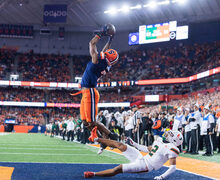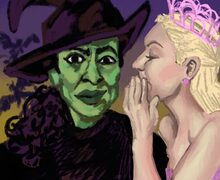Professor exhibits presidential photographs
Sam Maller | Asst. Photo Editor
Mike Davis, adjunct professor in the multimedia photography and design department in the S.I. Newhouse School of Public Communications, spoke Tuesday about his time as a White House photographer.
For four years, Mike Davis spent his workdays at many photographers’ dream job: editing photos from his office overlooking the White House lawn. He’s quick to inform anyone who asks, however, that the color of 1600 Pennsylvania Ave. is actually closer to beige.
Davis, an adjunct professor in the multimedia photography and design department in the S.I. Newhouse School of Public Communications, served as the deputy director of photography for the White House Photography Office from 2001-2004 under George W. Bush’s official photographer.
“You may have heard of presidential life as a bubble. The White House is a place where it is absolutely impossible to understand the place until you’ve been inside it,” Davis said.
Davis spoke in Newhouse at 7 p.m. Tuesday about his experiences working at the White House. He also discussed the experiences of White House photographers from the Franklin Roosevelt administration to the present.
Davis’ presentation was in conjunction with the Pictures of the Year International Show, “The Presidential Image,” which originated at the University of Missouri and is travelling across the country. Currently, it is showcased in the lobby of Newhouse I.
To give the audience insight into the presidential bubble, Davis presented images ranging from the first-ever photo of a president — an image of President John Quincy Adams — to more famous photos, such as President Lyndon Johnson’s Oval Office meeting with Martin Luther King Jr.
Davis also described what it was like for White House photographers during difficult moments, including the Sept. 11 attacks when he was a member of the White House staff.
He described the day as the scariest day of his life. The White House was haphazardly evacuated, he said, as there was no system in place for that type of emergency. But when word came that President Bush would be returning to the White House a few hours later, Davis immediately volunteered to return.
“The head of administration was going back to the White House and I asked, ‘Can I go? Somebody should be there when they get back,’” Davis said. “So I was maybe one of 15-20 people in the West Wing when the president arrived back that afternoon.”
Davis also noted that at times, his different political views did make it difficult to be a member of President Bush’s staff. During Davis’ tenure at the White House, he and one other co-worker, a member of the National Security Council, were the only non-Republicans on staff.
“That alone created a quandary. I disagreed with almost every policy they ever put forth, but he was the president, I did work for him,” he said.
Seth Gitner, a professor in the newspaper and online journalism department, said he was interested in how Davis’ presentation offered a more in-depth look at the presidency.
“Being behind the scenes, you get to see and hear about things as history happens. He has a front row to it,” Gitner said.
Taylor Barker, a junior photojournalism major, said her favorite part of Davis’ presentation and the display of the presidential photos in the Newhouse lobby was the images of the presidents in more candid moments.
Barker said that every photo offers a glimpse into the presidency and has the ability to freeze a moment in time, as well as tell a larger story. She said many of the photos on display showed a different side of the presidents, one she had never seen before.
Davis said the opportunity to depict every aspect of the presidency was what he spent the entirety of the Bush administration attempting to do.
Said Davis: “My job was to produce an archive of the presidency that was truthful and honest. We had a responsibility to the public as a whole to accurately represent what was happening.”
Published on January 23, 2013 at 12:40 am
Contact Avery: avhartma@syr.edu | @averyhartmans





